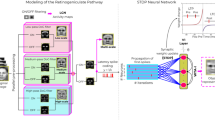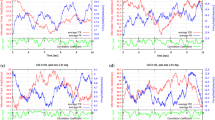Abstract
This article gives insights into the possible neuronal processes involved in visual discrimination. We study the performance of a spiking network of Integrate-and-Fire (IF) neurons when performing a benchmark discrimination task. The task we adopted consists of determining the direction of moving dots in a noisy context using similar stimuli to those in the experiments of Newsome and colleagues. We present a neural model that performs the discrimination involved in this task. By varying the synaptic parameters of the IF neurons, we illustrate the counter-intuitive importance of the second-order statistics (input noise) in improving the discrimination accuracy of the model. We show that measuring the Firing Rate (FR) over a population enables the model to discriminate in realistic times, and even surprisingly significantly increases its discrimination accuracy over the single neuron case, despite the faster processing. We also show that increasing the input noise increases the discrimination accuracy but only at the expense of the speed at which we can read out the FR.
Similar content being viewed by others
References
Britten K (2003) The middle temporal area:Motion processing and the link to perception. In: Chalupa WJ (eds) The visual neurosciences. MIT Press, Boston
Britten KH, Newsome WT, Shadlen MN, Celebrini S, Movshon JA (1996) A relationship between behavioral choice and the visual responses of neurons in macaque MT. Visual Neurosci 13:87–100
Britten KH, Shadlen MN, Newsome WT, Movshon JA (1992) The analysis of visual motion : a comparison of neuronal and psychophysical performance. J Neurosci 12:2331–2355
Deng Y, Williams P, Liu F, Feng JF (2003) Discriminating between different input signals via single neuron activity. J Phys A: Math Gen 36(50):12379–12398
Ditterich J, Mazurek M, Shadlen MN (2003) Microstimulation of visual cortex affects the speed of perceptual decisions. Nature Neurosci 6(8):891–898
Durrant S, Kendrick K, Feng JF (2005) Algorithms for exploiting negative correlation. Biosystems (accepted)
Feller W (1971) An introduction to probability theory and its applications, vol. 2, 2nd edition. Wiley, New York
Feng JF (2001) Is the integrate-and-fire model good enough? - a review. Neural Netw 14:955–975
Feng JF (2003) Effects of correlated and synchronized stochastic inputs toleaky integrator neuronal model. J Theor Biol 222:151162
Feng JF, Liu F (2002) A modelling study on discrimination tasks. Biosystems 67:67–73
Feng JF, Wei G (2001) Increasing inhibitory inputs increases neuronal firing rate. J Phys A: Math Gen 34:7493–7510
Gaillard B, Buxton H, Feng JF (2005). Neuronal model of decision making. In: Feng J, Qian M, Jost J (eds) Networks: from biology to theory. Springer, Berlin Heidelberg New York, (in preparation)
Gerstner W, Kistler W (2002) Spiking neuron models single neurons, populations plasticity. Cambridge University Press, Cambridge
Gold JI, Shadlen MN (2003) The influence of behavioral context on the representation of a perceptual decision in developing oculomotor commands. J Neurosci 23:632–651
Heeger DJ, Simoncelli EP, Carandini M, Movshon JA (1995) Computational models of cortical visual processing. In: Proc national academy of science, vol. 93, pp 623–627
Heekeren HR, Marrett S, Bandettini PA, Ungerleider LG (2004) A general mechanism for perceptual decision-making in the human brain. Nature 431:859–862
Koch C (1999) Biophysics of computation: information processing in single neurons. Oxford University Press, Oxford
Lee DK, Itti L, Koch C, Braun J (1999) Attention activates winner-take-all competition amongst visual filters. Nature Neurosci 2: 375–381
Liu J, Newsome WT (2003) Functional organisation of speed tuned neurons in visual area MT. J Neurophysiol 89:246–256
Parker AJ, Newsome WT (1998) Sense and the single neuron: Probing the physiology of perception. Annu Rev Neurosci 21:227–277
Rao RPN (2004) Bayesian computation in recurrent neural circuits. Neural Comput 16(1):1–38
Ratcliff R, Rouder JN (1998) Modeling response times for two-choice decisions. Psychol Sci 9:347–356
Ratcliff R, Van Zandt T, Mc Koon G (1999) Connectionnist and diffusion models of reaction time. Psychol Rev 106:261–300
Ricciardi LM, Sato S (1990) Diffusion process and first-passage-times problems. In: Ricciardi LM (eds) Lectures in applied mathematics and informatics. Manchester University Press, Manchester
Romo R, Hernandez A, Zainos A, Salinas E (2003) Correlated neuronal discharges that increase coding efficiency during perceptual discrimination. Neuron 38:649–657
Rorie AE, Newsome WT (2005) A general mechanism for decision-making in the human brain? Trends Cogn Sci 9 (advanced online publication)
Shadlen MN, Gold JI (2004). The neurophysiology of decision making as a window on cognition. In: Gazzaniga MN (eds) The cognitive neurosciences. MIT Press, Cambridge
Shadlen MN, Newsome WT (2001) Neural basis of a perceptual decision in the parietal cortex (area LIP) of the rhesus monkey. J Neurophysiol 86:1916–1935
Shadlen MN, Newsome WT (1996) Motion perception: seeing and deciding. PNAS 93:628–633
Sheth BR, Sharma J, Rao SC, Sur M (1996) Orientation maps of subjective contours in visual cortex. Sci 274:2110-2115
Simoncelli EP, Heeger DJ (1998) A model of neuronal responses in visual area MT. Vision Res 38:743–761
Sugrue LP, Corrado GS, Newsome WT (2005) Choosing the greater of two goods: neural currencies for valuation and decision making. Nature Rev Neurosci 6(5):363–75
Tovée Martin J (1996) An introduction to the visual system. Cambridge University Press, Cambridge
Tuckwell HC (1988) Introduction to theoretical neurobiology, vol 2. Cambridge University Press, Cambridge
Usher M, McClelland J (2001) On the time course of perceptual choice: the leaky competing accumulator model. Psychol Rev 108:550–592
VanRullen R, Koch C (2003) Is perception discrete or continuous? Trends Cognit Sci 7(5):207–213
VanRullen R, Thorpe S (2000) Is it a bird is it a plane? Ultra-rapid visual categorization of natural and artifactual categories. Perception 30(6):655–668
VanRullen R, Thorpe S (2001) Rate coding vs temporal order coding: what the retinal ganglion cells tell the visual cortex. Neural Comput 13:1255–1283
Wang XJ (2002) Probabilistic Decision Making by Slow Reverberation in Cortical Circuits. Neuron 36:955–968
Zohary E, Shadlen MN, Newsome WT (1994) Correlated neuronal discharge rate and its implications for psychophysical performance. Nature 370:140–143
Author information
Authors and Affiliations
Corresponding author
Rights and permissions
About this article
Cite this article
Gaillard, B., Buxton, H. & Feng, J. Population approach to a neural discrimination task. Biol Cybern 94, 180–191 (2006). https://doi.org/10.1007/s00422-005-0039-3
Received:
Accepted:
Published:
Issue Date:
DOI: https://doi.org/10.1007/s00422-005-0039-3




